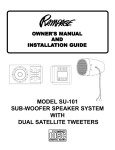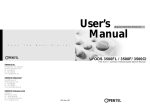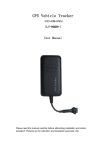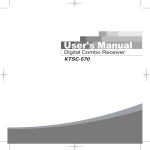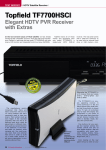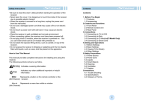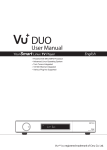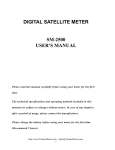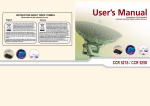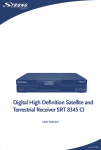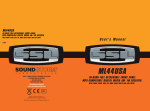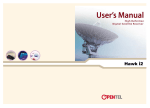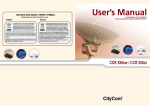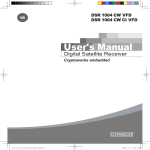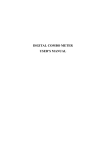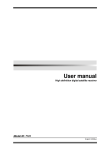Download User Manual
Transcript
User Manual Free To Air / Multi CAS Embedded Digital Satellite Receiver DigiTECH 5000F Contents 1. SAFETY INFORMATION 2 2. FEATURES 3 3. CONNECTING YOUR RECEIVER 4 4. CONTROLS AND FUNCTIONS 6 4.1 REMOTE CONTROL UNIT 6 4.2 FRONT PANEL 8 4.2 REAR PANEL 9 5. MENU GUIDE 10 5.1 INSTALLATION 10 5.2 SYSTEM CONFIGURATION 12 5.3 CHANNEL ORGANIZATION 13 5.4 PARENTAL LOCK 15 5.5 RECEIVER INFORMATION 15 5.6 OTHER FUNCTION 16 5.7 COMMON INTERFACE 16 6. TROUBLE SHOOTING 17 7. TECHNICAL SPECIFICATIONS 19 1. SAFETY INFORMATION Be sure to read this User’s Manual before starting the operation of the receiver. Do not open the cover. It is dangerous to touch the inside of the receiver due to possible electric hazard. 2. FEATURES MPEG-2 & Fully DVB Compliant MPEG-2 Video (MP@ML), MPEG-1 Audio Layer1,Layer2 PLL RF-Modulator UHF 21~69 with PAL B/G,I, D/K LNB Controlling Logic (0/22KHz Tone, 13/18V) SCPC/ MCPC Receivable from C/Ku-Band Satellite MAINS SUPPLY : 95�240V AC 50/60Hz LOCATION : Locate the receiver indoor. Locate receiver away from potential hazards such as houseplants, lighting, raining and direct sunlight. OVERLOADING : Do not overload wall outlets, extension cords or adapters as this can result in fire or electrical shock. LIQUIDS : Keep liquids away from the receiver. CLEANING : Before cleaning, disconnect the receiver from the wall socket. Use a cloth lightly dampened with water (no solvents) to clean the exterior. VENTILATION : Do not block the receiver ventilation holes. Ensure that free airflow is maintained around the receiver. Never set the receiver on soft furnishings or carpets. Do not use or store the receiver where it is exposed to direct sunlight, or near heater. Never stack other electronic equipment on top of the receiver. Place the receiver at least 30mm from the wall. ATTACHMENTS : Do not use any attachment that is not recommended by the manufacturer, as it may cause a hazard or damage the equipment. CONNECTION TO THE SATELLITE DISH LNB : The LNB connector cable has a voltage in its center core. It is therefore recommended that the receiver is disconnected from the mains power before connecting or disconnecting this cable. FAILURE TO DO SO COULD DAMAGE THE LNB. SERVICING : Do not attempt to service this product yourself. Any attempt to do so will make the warranty invalid.Refer all servicing to a qualified service agent. LIGHTNING : If the receiver is installed in an area subject to intense lighting activity, protection devices for the receiver mains connector and modem telephone line are essential. The individual manufacturer’ s instruction for safeguarding other equipment, such as TV set, Hi-Fi, etc., connected to the receiver, must also be followed during lighting storms. GROUNDING : The ground of the LNB cable must be directly connected to the system ground for the satellite dish. The grounding system must comply with local regulations. 2 Digital Tuner with Loop-through Wide Symbol Rate 1~45Mbps & Frequency Input 950~2150MHz DiSEqC1.2 Supported 2 SCART for TV, VCR User friendly OSD Menu with Full Function 256 Colors Graphic User Interface Multi-language Menu 4-digit 7-segment LED Display Variable Aspect Ratio (4:3, 16:9) with Pan Vector or Letter Box EPG(Electronic Program Guide) On-screen Channel Information Small Screen Picture on EPG Teletext and Subtitle Supported (VBI&OSD) Installation by Easy Setup Guide Fast Booting & Auto Scan Quick Channel Changing Max. 4000 Channels(TV & Radio) Programmable Radio Channel Background Display Favorite Channel List Programmable Master PIN Code Function & Parental Lock Function Automatic Detection of Forward Error Correction Automatic NTSC / PAL Detection and Simple Video Converter S/W Download Program Supported by RS232 Serial Port Set to Set Download 3 RCA Output for Video, Audio L/R Games (SOKOBAN & SLOT machine) Digital Audio Output : S/PDIF(Option) 3 3. CONNECTING YOUR RECEIVER There are several ways of connecting the receiver to your TV, VCR and / or Hi-Fi SYSTEM. Consult your local supplier for assistance in setting-up your system that is best suited to your requirements. 2) CONNECTING THE RECEIVER WITH DISH SYSTEM Hi-Fi Stereo Audio TV ANTENNA SATELLITE ANTENNA After installing your dish system, connect the coaxial cable from LNB of your dish antenna to “LNB IN”terminal marked at the rear of the receiver. All cable connectors should be finger tightened ; do not use any kind of wrench on the cable over connectors. The cable should be 75Ϊ impedence coaxial twisted at the end with a“F”type connector. 3) CONNECT RECEIVER TO A TV SAT Connect your receiver to a TV sat with SCART, if your TV set is equipped for it. Alternatively you can use A/V or TV out(UHF). 4) CONNECT RECEIVER TO A VCR Connect the SCART jack from the VCR to the back of your receiver. Alternatively you can use A/V or TV out(UHF). 5) CONNECT RECEIVER TO A Hi-Fi SYSTEM Connect a RCA stereo cable from the AUDIO L/R jacks, S/PDIF on your receiver to the LINE, AUX, SPARE or EXTRA input jacks on your Hi-Fi System. VCR TV 6) CONNECT RECEIVER TO A DIGITAL AUDIO SYSTEM If you have DAC with S/PDIF optical cable input, you can connect the STB with it to enjoy higher quality sound. Connect S/PDIF optical cable to a digital amplifier. 1) LOCATION OF THE RECEIVER Your receiver should be placed under proper ventilation. Don’ t put in completely enclosed cabinet that will restrict the flow of air, Resulting overheating. The location should be safeguarded from direct sunlight, excess moisture, rough handling or household pets. Avoid stacking other electronic components on the top of the receiver. The location should be safely accessible by the cable from your antenna system. 4 7) LOOP THROUGH If you have another analogue or digital receiver and you wish to use the same LNB then you can connect it via the loop through. Connect one of end the coaxial cable to the “IF OUT” on the receiver and connect the other end to the “LNB IN” on your second receiver. Now by keeping the receiver in standby, you will be able to tune and view the channels from the receiver. 5 4. CONTROLS AND FUNCTIONS 4. 1. REMOTE CONTROL UNIT 1) POWER : This is used to switch the receiver to ON/STANDBY mode. LAST 15) LAST : This key is used to return to the previous channel. 2) MUTE : This key is used to toggle between normal and muted audio. AUDIO 16) AUDIO : This key is used to select the soundtrack list for the current service and also used to select audio mode. PAUSE 17) PAUSE : This key is used to pause the screen. 4) CH ▲∙CH ▼ : These keys are used to change channels and to browse the menu. NTSC / PAL 18) NTSC/PAL : This key is used to convert video mode. 5) VOL ▶∙VOL ◀ : These keys are used to control the volume level and to change the cursor options in the menu. SAT 19) SAT : This key is used to select the satellite. MENU 6) MENU : This key is used to open up the menu. TV/ SAT 20) TEXT : This key is for Teletext. EXIT 7) EXIT : This key is used to exit from any menus. 0 ~ 9 OK 3) 0-9 NUMERIC KEYS : These keys are used to enter numeric values and to select the channel directly by entering its number. 8) OK : This key is used to enter or confirm any data in the menu systems.The Channel list can be accessed directly by pressing this Key in the normal view mode. F1 F2 F4 F3 21). F1, F2 and F3 : Function Keys. 22). F4 : Zoom and Function Key. 9) Page Up : This key is used to page up the menu. 10) Page Down : This key is used to page down the menu. FAV 11) FAV : This key is used to switch between favorite lists. GUIDE 12) GUIDE : This key is used to open up the Electronic Program Guide. i 13) i : This key is used to view the channel information. 14) 6 : This key is used to toggle between the TV channel and the radio channel. 7 4. 3. REAR PANEL 4.2. FRONT PANEL 1) LNB IN : This is to Connect the coaxial cable from LNB of your Dish. 1) POWER : Push the receiver on and off (stand by). 2) IF OUT : This is to enable the connection of an other receiver, The receiver is provided with this port. Connect this port to LNB IN port of the other receiver via RF Cable. 3) ANT IN : This is used to connect your local RF channels to your TV through Loop 2) CH : Changes the channels and moves the cursor up / down in menu mode. 4) TV OUT : This is used to connect your TV through RF cable. 3) VOL : Increases and decreases the volume level manually and changes setting in menu mode. 6) VIDEO, AUDIO R/L : These RCA connectors are used to connect any external video and audio. 5) SERIAL PORT : This is used to connect your receiver with computer through a serial cable. This port can be used for upgrading software. 7) TV SCART : This is used to connect your TV through SCART. 8) VCR SCART : This is used to connect your VCR. 4) INFRARED SENSOR : This is to receive the IR commands from the RCU. Do not block the view of the sensor. 5) 7 SEGMENT DISPLAY : This SEGMENT display will show the current channel number.While the receiver is in stand by mode, the display will show the current time. 9) S/PDIF (DIGITAL OUTPUT) : This port is for the connection to the exterual Hifi system which has a optical S/PDIF input interface. (Option) 10) POWER INPUT : This is to plug in the AC main power cord. The input AC volts range is 95V to 240V, 50Hz/60Hz supply. ① ③ ② ④ ⑥ ⑦ 6) SMART CARD INTERFACE SLOTS : To watch scrambled channels you should insert a smart card into Smart Card Interface issued the service provider whom you subscribes to. Therefore you can watch only a specific range of channels with entitlements in smart card. The smart card includes information to decipher parameters necessary for descrambling the program. Please note that the gold chip on the smart card should face download and inward when you insert when you insert it into Smart Card Interface. (Option for CAS model only) 8 ⑤ ⑧ ⑩ 9 5. MENU GUIDE The main menu is classified into five menus which will carry out the various operation individually. Main Menu Press the “MENU” key in the RCU. You will see the “Main Menu” on the screen. 1) You can move into the desired submenu using “UP” key or “DOWN” key. 2) Press “OK” key to confirm your selection. 3) Press the “MENU” key or “EXIT” key to return to previous menu. d. LNB High : You can select the LNB Frequency. Using the volume “UP/DOWN”(◀∙▶) keys or numeric keys. e. LNB Low : If you can use the Universal LNB, you can select the LNB low frequency. Using the volume “UP/DOWN” (◀∙▶)keys or numeric keys. f. 22KHz : If you have 22KHz tone box, you can supply either 22KHz by setting “ON” or not by setting “OFF”. Using the volume “UP/DOWN” (◀∙▶)keys or numeric keys. g. DiSEqC Type : If you have DiSEqC box, you can select and use appropriate port for your DiSEqC box. Using the volume “UP/DOWN”(◀∙▶) keys. h . DiSEqC 1.2 motor : If you have DiSEqC 1.2 motor, please select “ On. 5.1.2 Channel Search 5.1. Installation This is to install Antenna Setup, Channel Search, Factory Default and Code. 5.1.1 Antenna Setup In this menu you can see satellite information and antenna (dish) setup. Select theSatellite, LNB Power, LNB Type, LNB High, LNB Low, 22KHz, DiSEqC Type or DiSEqC 1.2 motor. Press “OK” key to move to Channel Search menu after storing your selection in Antenna Setup. a. Satellite : You can select the desired satellite using the volume “UP/DOWN” (◀∙▶) keys. b. LNB Power : You can select the LNB Power ON or OFF. Using the volume “UP/DOWN” (◀∙▶) keys. c. LNB Type : You can select the Universal LNB or Standard LNB. Using the volume “UP/DOWN” (◀∙▶)keys. 10 The menu shows all transponders in satellite and edit satellite, edit transponder to scan the satellite. a. Satellite : You can select the desired satellite using the volume “UP/DOWN”(◀∙▶) keys. If you want Multi Search, press “OK” key and then select other satellites. b. Network : You can select the Network search using the volume “UP/DOWN”(◀∙▶) keys. c. Add Satellite : You can add a new satellite using the “OK” key. d. Delete Satellite : You can delete USER satellite using the “OK” key. e. Add TP : You can add a new transponder using the “OK” key. f. Delete TP : You can delete transponder using the “OK” key. g. Search mode : You can select the FTA(free to air)+SCM(scrambled) or FTA, SCM using the volume ‘UP/DOWN”(◀∙▶) keys. h. Transponder Search : Press “OK” key to start transponder search for selected transponder. i. Satellite Search : Press “OK” key to start satellite search for selected satellite. 11 5.1.3 Factory Default To reset the receiver, select “Factory Default” in “Installation” and press “Yes” icon on the screen. The receiver will be reset automatically. 5.2. System Configuration 5. 3. Channel Organization This menu helps you to set up Screen Format, Video Output mode, UHF mode, language, time mode. a. Screen Format : You can select the screen format (4:3, 16:9, Letter Box) using the volume “UP/DOWN”(◀∙▶) keys. b. Video Output : You can select the video output mode (CVBS, RGB) using the volume “UP/DOWN”(◀∙▶) keys. c. UHF Mode : You can select the UHF mode (PAL B/G, I, D/K) using the volume “UP/DOWN”(◀∙▶) keys. 12 d. UHF Channel : You can select the UHF channel (21 ~ 69) using the volume “UP/DOWN”(◀∙▶) keys. e. OSD Language : You can select the OSD language (Menu language) using the volume “UP/DOWN”(◀∙▶) keys. f. Audio Language : You can select the audio language using the volume “UP/DOWN”(◀∙▶) keys. g. Time Mode : You can select the Time mode (Auto, Manual) using the volume “UP/DOWN”(◀∙▶) keys. h. Current time : You can input the time using the numeric keys in case of selecting “Manual” in Time Mode. i. Time Adjustment : You can adjust the time using the volume “UP/DOWN”(◀∙▶) keys in case of selecting “Auto” in Time Mode. 5.3.1 Edit Channel List This menu helps you to select the channel that you want to watch easily. a. Channel lock : Press “F1” F1 b. Delete channel : Press “F2” F2 to lock the channel in the channel list. to delete the channel in the the channel list.. 13 a. Receiver Lock: Select “On” to have Receiver Lock. b. Maturity Rate: Select “ Number” to prevent children from watching.. c. Change Password: Put the new password if you want to change new password number. c. Move channel : Press “F3” F3 to move the channel in the the channel list. d. Edit channel name : Press “F4” F4 to rename the channel in the the channel list. 5.3.2 Edit Favorite List This menu helps you to select the channel that you want to watch easily. 5.5. Receiver Information It displays receiver information on H/W, S/W version and Loader version. a. Add to fav. channel : Press “F1” F1 key to add the channel into favorite channel list. b. Delete fav. Channel : Press “F2” F2 key to delete the channel in the favorite channel list. c. Move fav. Channel : Press “F3” F3 key to move the channel in the favorite channel list. d. Rename fav. Group : Press “F4” F4 to rename channel in the favorite channel list. 5.6 Other Function 5. 4. Parental Lock This menu prevents children or unauthorized persons from watching programs. Also you can change password. 14 5.6.1. EPG (Electronic Program Guide) This is to see channel guide information to get current and next channel program schedules. Press Guide GUIDE Key. 15 6. TROUBLE SHOOTING There may be various reasons for the abnormal operation of the receiver. Check the receiver according to the procedures shown below . 5.6.2. Teletext This is to get channel date through the stream. Please press text. TEXT Key. 5.6.3. Zoom Function This is to see a part of the screen in detail. Press F4 Key and choose a part of screen using the Volume “UP/Down” and CH. “UP/Down” keys. And press “OK” key. The part of the screen is extened. If you can’t solve the problem even after referring this trouble shooting, please contact the dealer. Don’t open the receiver cover. It may cause a dangerous situation. Symptom The front panel doesn’t display any message 6. Common Interface (Option function) This receiver is equipped with two slots of Common Interface. When a common interface CAM is inserted inside the PCMCIA slot, the receiver detects the type of the CAM automatically and display in the menu. No picture or sound. Cause Result The power cord is not plugged in Check that the power cable is plugged in to the wall outlet. Wrong connection in the Audio / Video output of the receiver to TV. Connect the Audio / Video output of the receiver to TV correctly. Wrong connection of the satellite antenna. Connect the antenna cable correctly. No or Bad signal message appears. Check other device connected between LNB and the receiver, or adjust the antenna position. Audio muting. press the MUTE button. TV power off. Turn TV on The receiver can’t receive the signal. Check the antenna cable, replace the cable, or connect the cable to the receiver tightly. Incorrect values of some tuner parameters. set the values of tuner parameters correctly in the Installation Menu. No picture. 16 17 7. TECHNICAL SPECIFICATIONS Symptom Cause Result The satellite dish is not pointing at the satellite. Adjust the dish. Signal too strong Connect the signal attenuator to the LNB input. No or bad signal Satellite dish is too small. Change to a larger dish. The LNB is faulty. Change the LNB. You have forgotten your PIN number 1. Power Supply Type Input Voltage Fuse Rating : SMPS : 95�240VAC 50/60 Hz : 250V/T2A 2. Tuner Input Frequency Input Signal Level Input Impedance Connector Type LNB Power Supply 22KHz Tone DiSEqC Channel Selection : 950�2150MHz : -65�-25dBm : 75Ϊ Unbalanced :‘F’Type Female : 13V/18V, Max 500mA with Short Circuit Protection : Frequency 22± 4KHz, Amplitude 0.6±0.2Vpp : 1.0 & 1.2 Version Compatible : PLL Frequency Synthesizer Contact your dealer, and then reset your receiver. 3. Demodulator The remote controller does not operate. The batteries of the remote controller are not inserted or exhausted. Check whether the batteries are inserted correctly in your remote controller. Check and replace the batteries of the remote controller. Type Symbol Rate Inner FEC Outer FEC : QPSK Demodulation(DVB-S) : 1�45 MS/s : Viterbi Convolutional Coding Rate 1/2, 2/3, 3/4, 5/6, 7/8 : Reed Solomon Coding(204,188) T=8 4. Video Decoder System Decoding Profile and Level Data Rate Video Formats 18 : : : : MPEG-2 ISO/IEC 13818-2 MPEG-2 MP@ML 1�15 MB/s 4:3(Normal) & 16:9(Widescreen) 19 5. Audio Decoder System Decoding Audio Mode Sampling Frequency : MPEG-1 ISO/IEC 11172-3 Layer I & II : Mono, Dual, Stereo, Joint Stero : 32, 44.1, 48 KHz 6. Audio/Video Output TV SCART VCR SCART RCA Jack S/PDIF (Option) : CVBS, RGB, Audio L/R : CVBS, Audio L/R : CVBS, Audio L/R : Digital Audio 7. RF Modulator Modulator Output Video Type UHF Output Level Output Connector Ant. IN Connector Tuning Method : CH21�69 (Preset To CH38) : PAL B/G, I, D/K : 71±4 dBμ V : IEC Male : IEC Female : PLL Frequency Synthesizer 8. Serial Data Interface Signal Connector Type : RS-232, Max. 38400 bps : 9 Pin D-Sub(male) 9. Common Interface Module Type Available CAM 20 : PCMCIA Type II×2 : Viaccess, Irdeto, Nagravision, Cryptoworks, Conax, SECA












